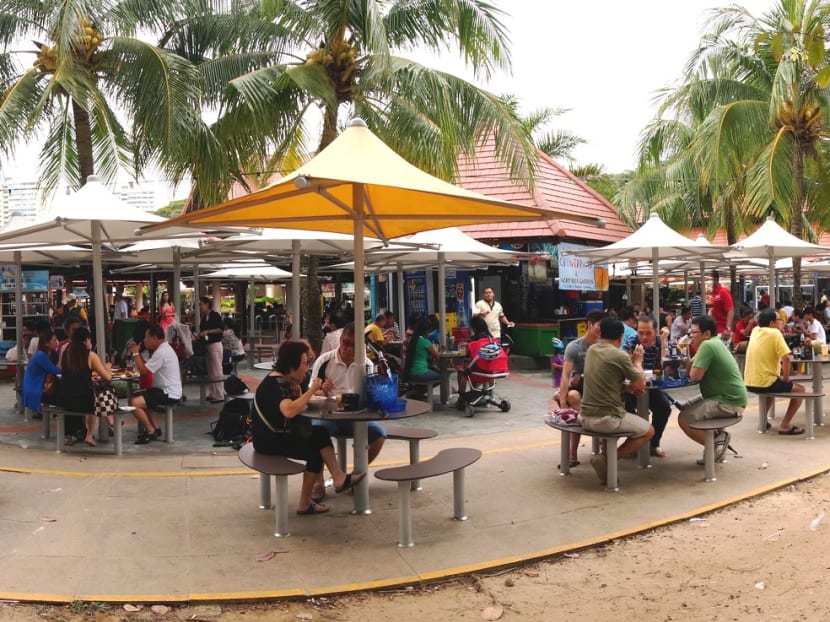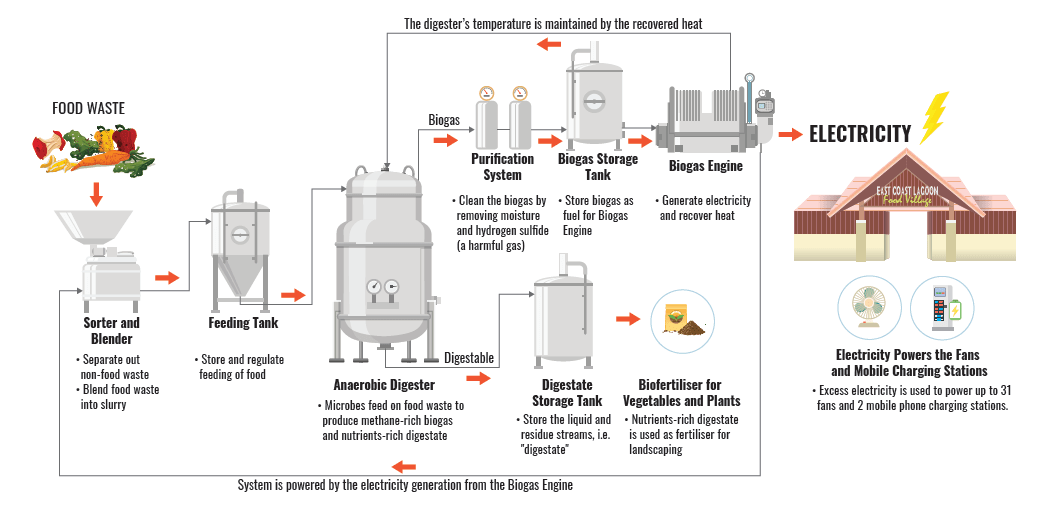Pilot project to use hawker centre food waste to generate electricity, produce fertiliser

A general view of East Coast Lagoon Food Village. (File photo: National Environment Agency)
SINGAPORE: Food waste at East Coast Lagoon Food Village will be used to generate electricity and produce fertiliser as part of a pilot project, the National Environment Agency (NEA), National University of Singapore (NUS) and National Parks Board (NParks) said in a joint news release on Wednesday (Nov 17).
An anaerobic digestion system for food waste treatment developed by NUS researchers will convert food scraps and leftovers into biogas and bio-fertiliser. A biogas engine will then convert the biogas into electricity, while the bio-fertiliser will be used for landscaping applications.
“Food waste is one of the priority waste streams identified under Singapore’s Zero Waste Masterplan,” the media release said.
“In 2020, food waste accounted for about 11 per cent of the total waste generated in Singapore, but only 19 per cent of the food waste was recycled. The rest of it was disposed of at waste-to-energy plants.
“Therefore, reducing food wastage, redistributing unsold or excess food, and recycling/treating food waste are important food waste management strategies.”
The holistic management of food waste also helps to prevent the contamination of other recyclables, and stops the spread of vermin and bad odours, it added.
The pilot is supported by NEA under its Closing the Waste Loop research and development initiative.
“Innovations such as on-site anaerobic digestion make it possible to create useful products from food waste, which would otherwise have to be sent for incineration,” said Patrick Pang, NEA’s chief technology officer.
“Such technologies help to reduce the environmental footprint of managing food waste and contribute to a circular economy.”
HOW IT WORKS
The anaerobic digestion system works by allowing microbes to feed on source-segregated digestible food waste like fruit and vegetable trimmings, preparation scraps from hawker stalls and leftovers from diners.
As part of the process, the microbes produce biogas which is rich in methane, and nutrient-rich digestate.
“Biogas is used to run a gas engine to generate electricity, while the digestate could be used as fertilisers for ornamental plants and landscaping applications,” the news release said.

The electricity will be used to power the digestion system itself, as well as two mobile phone charging stations for the public. Excess electricity can also be used to power up to 31 wall-mounted fans at East Coast Lagoon Food Village.
The digestate produced by the system will be studied by NParks for use at East Coast Park.
Group director for Parks East at NParks Chia Seng Jiang said: “NParks is working closely with NUS researchers on the experimental design of this project and practical applications of the digestate.
“We are identifying pilot sites at East Coast Park to test the efficacy of the digestate as fertiliser.”
Anaerobic digestion technology is in use around the world but it is typically implemented at off-site or centralised facilities, NEA, NUS and NParks said in the release.
“This pilot project, however, examines the feasibility of using anaerobic digestion as an on-site treatment solution to close the food waste loop at the source of food waste generation,” they added.
The pilot will “gather longer term, real-world data while showcasing that a customised anaerobic digestion system at the food village is feasible and practical”.
Stallholders and table cleaners have been provided with covered bins to aid in the segregation of food waste, and the contents of these bins will be emptied into five “smart bins” placed around the hawker centre. These smart bins record data on the amount of segregated food waste each user deposits.
The hawker centre has about 60 occupied stalls which together produce about 150kg of digestible food waste each day.
Associate Professor Tong Yen Wah from the NUS Department of Chemical and Biomolecular Engineering will lead the team overseeing the operation and maintenance of the anaerobic digestion system.
The team will also study the human psychology and behavioural factors in encouraging hawkers and cleaners to segregate food waste from other waste.
“Our NUS team is excited to be leading this effort, with support from NEA and NParks, to reduce waste in Singapore and turn food scraps into a green energy resource,” Assoc Prof Tong said.
“Our technology is unique because it is easy to operate, and can now generate heat, fertiliser and electricity for areas at or around the hawker centre.
“When coupled with the human behavioural studies, our system is no longer just mere technology, but a component of social change that will help to ensure the success of an on-site system to close the food waste loop at its source.”








